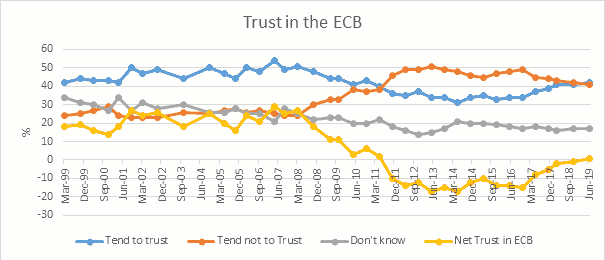In her first press conference as president of the European Central Bank on December 12th, Christine Lagarde announced a comprehensive strategic review. This, she said, ‘needs to look at all and every issue, will turn each and every stone and will take its time but will not take too much time’.
Such a review is overdue: the last was in 2003. But a more fundamental case for it is the declining trust of the citizens of the euro area in the ECB. According to Eurobarometer, this fell during the eurozone crisis and has only partially recovered (see graph).
Yet the bank has been very successful in meeting its mandate and stimulating the euro-area economy. Communication of the existing strategy has thus completely failed.

Two main functions
A central-bank strategy has two main functions: an interpretation of its mandate and elaboration of an associated analytical framework. In the case of the ECB, the mandate is given by article 127 of the Treaty on the Functioning of the European Union:
The primary objective of the European System of Central Banks (hereinafter referred to as ‘the ESCB’) shall be to maintain price stability. Without prejudice to the objective of price stability, the ESCB shall support the general economic policies in the Union with a view to contributing to the achievement of the objectives of the Union as laid down in Article 3 of the Treaty on European Union.
Thus, its strategy must provide a concrete definition of ‘price stability’ and address how the ECB can help realise the objectives in article 3.
Designing a framework which describes how the ECB is trying to fulfil its mandate in day-to-day operations should serve as a heuristic. This can reduce the complexity of a central bank’s decision-making in a way that it can be understood by at least the informed public.
Price stability
In a strict sense, ‘price stability’ could be understood as a zero inflation rate. But if a central bank tries to achieve zero inflation in normal times, any negative demand or supply shock will drive the economy on to the terrain of deflation. As is well known, the zero lower bound of interest rates makes it very difficult to fight deflation, which could then become a chronic disease. In addition, in a monetary union an average inflation rate of zero would require deflation in several member states, even in normal times.
The risk of deflation also militates against an inflation target of 1 per cent. Therefore, in developed countries most central banks have decided on a mid-point inflation target of 2 per cent. In its 2003 strategic review, the ECB opted for a target of ‘below, but close to, 2 per cent over the medium term’. It is not obvious that any revision is required: a target of 2 per cent per se might be preferable but this would not mean fundamental change.
In 2003, the ECB did not make explicit whether the target was asymmetric or symmetric. But already the focus on the ‘medium term’ made it clear the bank was not trying to fine-tune inflation. The symmetry of the target was made apparent in the more recent past. For example, at a press conference in March 2016 the then president, Mario Draghi, noted:
[O]ur mandate is defined as reaching an inflation rate which is close to 2 per cent but below 2 per cent in the medium term, which means that we’ll have to define the medium term in a way that, if the inflation rate was for a long time below 2 per cent, it will be above 2 per cent for some time. The key point is that the Governing Council is symmetric in the definition of the objective of price stability over the medium term.
The symmetry of the target could however be made more explicit.
Then the only remaining question is whether the ECB should follow the practice of some central banks and announce a concrete corridor for its inflation target. Compared with the ambiguity of the current definition, though, this could lead to negative impacts on the ECB’s credibility if a specific shock were to drive inflation outside the corridor.
Green focus
At the same press conference Lagarde promised to give the ECB strategy a green focus, saying that ‘we will take up climate change, we will take up the fight that is taken up by the European Commission and I hope other European institutions, and see where and how we can participate in that particular endeavour’. In contrast, the president of the Bundesbank, Jens Weidmann, had warned some weeks previously that a monetary policy which explicitly followed environmental targets would risk being overburdened.
Climate change must be tackled first of all by governments, not central banks. Governments have effective tools for the fight, including carbon taxes and subsidies for renewable energies, carbon-free mobility and more energy-efficient housing and manufacturing.
If the public expenditures to resist climate change cannot be financed from current revenues, they should be financed by deficits: as the benefits of climate policies accrue to the younger generations there is no reason to exclude deficit financing. In the euro area, this will require a more flexible interpretation of the Stability and Growth Pact, but this is not an unsurmountable obstacle.
Financing projects
For the financing of public and private green projects powerful public banks already exist, such as the Kreditanstalt für Wiederaufbau in Germany. At European level, the European Investment Bank is a strong institution which finances a large spectrum of green investments.
On November 14th last, the EIB board approved a new strategy for climate action and environmental sustainability: the EIB Group will aim to support €1 trillion of investments in the critical decade to 2030, seeking to increase the share of its financing dedicated to climate action and environmental sustainability to 50 per cent by 2025.
Compared with this, the contribution of central banks is not so obvious. The ECB’s responsibility for climate policy can be derived from article 3 of the treaty, which mentions ‘a high level of protection and improvement of the quality of the environment’ as a core objective of the union. But this raises the question as to which concrete instruments the ECB could use to support the fight against climate change. There are two main options: its framework for collateral in refinancing commercial banks and its purchases of bonds in asset-purchase programmes.
The Eurosystem—the central banks of the member states and the ECB—provides credit only against adequate collateral. The eligibility of assets is assessed by the national central banks, according to the criteria specified in the Eurosystem’s legal framework for monetary-policy instruments. One option to support ‘green corporations’ could be to reduce the requirements for the quality of such collateral. But this would create a trade-off between financial stability and climate policy which should be avoided.
Another avenue would be excluding assets associated with certain ‘brown corporations’ from the catalogue of those eligible. For banks which did not have a sufficient amount of ‘green collateral’ as a substitute, this would reduce their refinancing from the ECB, with negative consequences for their lending and the real economy. This could create a trade-off between climate policy and macroeconomic stability, which could even impair the main target of price stability. Discriminating against ‘brown corporations’ in collateral policy should thus only be a medium-term perspective, to give banks sufficient time for adjustment.
As for the purchase of green bonds, Paul de Grauwe has proposed that the ECB should purchase EIB bonds and thus indirectly finance a €1 trillion green investment programme by the EIB. But given the excellent rating of this institution and an overall EIB balance sheet of more than €500 billion, it is not clear why the EIB might need such support from the ECB.
In its purchases of corporate bonds the ECB could decide to buy only ‘green bonds’, according to an assessment made by a third institution. Again, the discrimination against ‘brown bonds’ could at least in the short run lead to a conflict between climate policy and macroeconomic stability if there were not a sufficient supply of green bonds. And, given the growing interest of many private investors in the latter, it is again questionable whether such support from the ECB is really needed.
This raises the more general problem of whether the ECB should become a permanent financing institution for green private investments. It would be very difficult to do this in a ‘market-neutral’ way, so that the ECB would have to replicate functions of the EIB. In addition to a blurred division of labour between these two European institutions, the ECB would become a competitor of private banks, for which financing the ecological restructuring of the whole economy is a promising business model.
In other words, the ECB’s place should not be at the forefront of the fight against climate change. First and foremost, that is up to the governments of the member states and the existing development banks, which have strong weapons at their disposal. The ECB should become active with bond purchases only if major financing problems arise. And it should then focus on government or EIB bonds.
Decision-making processes
An important function of a strategy is to make the decision-making processes of a central bank understandable to a wider audience. In this case it is also helpful vis-à-vis the internal decision-making of the ECB’s governing council, with its 25 members.
It was obvious from the beginning that the two-pillar basis of the existing strategy was inadequate. With its ‘economic analysis’ and ‘monetary analysis’, the strategy simply stated the obvious: in its decision-making the ECB will monitor all relevant real and monetary data. The only reduction of complexity was provided by a reference value for the growth rate of the money stock, M3. But this heritage from the Bundesbank’s strategy was flawed from the outset and after some years was discarded from the ECB’s economic bulletins.
The obvious heuristic for a new strategy is inflation targeting. Many central banks in developed and emerging market economies are following this strategy successfully. In fact, the ECB is already practising de facto an implicit inflation targeting. On a quarterly basis, its staff are producing ‘inflation projections’, which are presented at the ECB’s press conferences.
In addition, the ECB organises a Survey of Professional Forecasters, which collects information on the expected rates of inflation and other macroeconomic variables in the euro area on various horizons, ranging from the current year to the longer term. This allows a comparison of the internal projections with outside forecasts and provides an objective benchmark for inflation targeting.
With explicit inflation targeting the ECB could always explain its decisions by the projected path of inflation relative to its target. This would force its critics to present their own inflation forecasts and would allow an ex-post evaluation of the ECB and those who challenge it.
This article is a joint publication by Social Europe and IPS-Journal
Peter Bofinger is professor of economics at Würzburg University and a former member of the German Council of Economic Experts.

